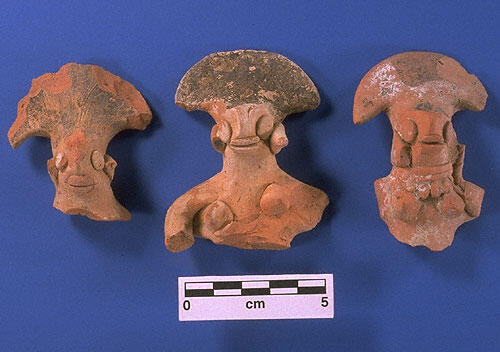A comprehensive and important paper that actually takes on the much larger question of Mesopotamian to Indus influence which animated the work of earlier archaeologists. Clark discusses so-called "Harappan courtiers," figurines with tiaras and flower headresses that are thought to have parallels with Mesopotamian artifacts, particularly the royal burial goods of Queen Puabi. Clark writes of "interpretations of the figurines [that] implicitly invoke a larger construction, the diffusionist model of Mesopotamian hegemony. Mesopotamian civilization is given primacy as the original civilization while others are considered secondary and derivative . . .. The larger objectives of this essay are to discuss what can reasonably be deduced from the available archaeological evidence, focusing on the figurine corpus, and to explore the nature of interactions between the Indus Civilization and Mesopotamia, which involves re-examining the long-standing notion of Mesopotamian primacy" (p. 159).
There is an excellent chronological table from 3300 BCE to about 1700 BCE comparing ancient Indus and Mesopotamian cultural periods. Clark then systematically demolishes some of the claims about these figurines, starting with the one that the clay models used to fashion them were similar. Rather, Indus people used a completely different method of combining two vertical strips of clay into a figurine as opposed to the Mesopotamian violin-shaped torso as the basis to which arms and legs were attached. "The construction of the figurines from vertical halves rather than from a ‘core’ implies that the figurine tradition of the Indus Civilization was indigenous to South Asia rather than the result of diffusion from a greater ancient Near Eastern ‘core’ to an Indus periphery" (p. 162).
She also shows that the time periods for the Puabi courtiers and figurines do not overlap, there is a gap of a few hundred critical years. The nature of the headdresses involved is also taken to be different: "Nor are the pendant leaves and pendant rings of the Sumerian headdress depicted on any of the headdresses of Indus figurines. Flowers are also sometimes depicted as earpieces on Indus figurines (particularly on those with a tiara decoration on the headdress), and similar earpieces are not found on any of the Sumerian attendants. Moreover, since similar flowers occur naturally in so many areas of the world, the occurrence of this particular motif in more than one area is not necessarily significant . . .. Clearly the headdresses and other ornamentation differ substantially, even when compared in the most general way" (p. 170).
On an even more basic level, there is little if any evidence for Mesopotamians living in Indus cities, and quite a bit for the other way around, so who is likely to have influenced who? "The real issues are the direction and nature of this contact, which are predicated upon the secure dating of archaeological materials in each area. Often assumed to be the result of Mesopotamian hegemony, perhaps this contact was initiated instead by an autonomous and enterprising Indus Civilization" (p. 172).
She concludes this very well-reasoned paper with the observation: "Re- evaluating the perception of Mesopotamian supremacy with regard to the Indus Civilization acknowledges the possibility that both civilizations developed simultaneously and independently and that the influence of the Indus Civilization upon Mesopotamia should be given equal privilege. The interactions between these two civilizations were assuredly complex and dynamic, and our understanding of these relationships must continuously be re-evaluated as new archaeological and other evidence becomes available" (p. 172).
Image: Three female figurines with painted fan-shaped headdresses from Harappa. Approximate dimensions (W x H x D) of the most complete figurine: 6.1 x 7.5 x 3.2 cm. Photo: Sharri R. Clark
Originally published in the book INTERCULTURAL RELATIONS BETWEEN SOUTH AND SOUTHWEST ASIA. STUDIES IN COMMEMORATION OF E.C.L. DURING CASPERS (1934-1996) E. Olijdam & R.H. Spoor (eds), BAR International Series 1826 (2008): 158-174.
- Log in to post comments

